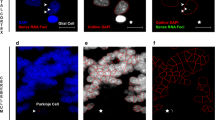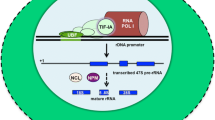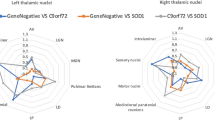Abstract
We investigated whether chromosome 9 open reading frame 72 hexanucleotide repeat expansion (C9orf72 expansion) size in peripheral DNA was associated with clinical differences in frontotemporal degeneration (FTD) and amyotrophic lateral sclerosis (ALS) linked to C9orf72 repeat expansion mutations. A novel quantification workflow was developed to measure C9orf72 expansion size by Southern blot densitometry in a cross-sectional cohort of C9orf72 expansion carriers with FTD (n = 39), ALS (n = 33), both (n = 35), or who are unaffected (n = 21). Multivariate linear regressions were performed to assess whether C9orf72 expansion size from peripheral DNA was associated with clinical phenotype, age of disease onset, disease duration and age at death. Mode values of C9orf72 expansion size were significantly shorter in FTD compared to ALS (p = 0.0001) but were not associated with age at onset in either FTD or ALS. A multivariate regression model correcting for patient’s age at DNA collection and disease phenotype revealed that C9orf72 expansion size is significantly associated with shorter disease duration (p = 0.0107) for individuals with FTD, but not with ALS. Despite considerable somatic instability of the C9orf72 expansion, semi-automated expansion size measurements demonstrated an inverse relationship between C9orf72 expansion size and disease duration in patients with FTD. Our finding suggests that C9orf72 repeat size may be a molecular disease modifier in FTD linked to hexanucleotide repeat expansion.




Similar content being viewed by others
References
Al-Chalabi A, Hardiman O (2013) The epidemiology of ALS: a conspiracy of genes, environment and time. Nat Rev Neurol 9:617–628. doi:10.1038/nrneurol.2013.203
Allignol A, Schumacher M, Beyersmann J (2011) Empirical transition matrix of multi-state models: the etm package. J Stat Softw 38:1–15
Beck J, Poulter M, Hensman D et al (2013) Large C9orf72 hexanucleotide repeat expansions are seen in multiple neurodegenerative syndromes and are more frequent than expected in the UK population. Am J Hum Genet 92:345–353. doi:10.1016/j.ajhg.2013.01.011
Bender R, Lange S (2001) Adjusting for multiple testing—when and how? J Clin Epidemiol 54:343–349
Brettschneider J, Van Deerlin VM, Robinson JL et al (2012) Pattern of ubiquilin pathology in ALS and FTLD indicates presence of C9ORF72 hexanucleotide expansion. Acta Neuropathol 123:825–839. doi:10.1007/s00401-012-0970-z
Brooks BR (1994) El Escorial World Federation of Neurology criteria for the diagnosis of amyotrophic lateral sclerosis. Subcommittee on Motor Neuron Diseases/Amyotrophic Lateral Sclerosis of the World Federation of Neurology Research Group on Neuromuscular Diseases and the El Escorial “clinical limits of amyotrophic lateral sclerosis” workshop contributors. J Neurol Sci 124(Suppl):96–107
Byrne S, Elamin M, Bede P et al (2012) Cognitive and clinical characteristics of patients with amyotrophic lateral sclerosis carrying a C9orf72 repeat expansion: a population-based cohort study. Lancet Neurol 11:232–240. doi:10.1016/S1474-4422(12)70014-5
Chio A, Calvo A, Mazzini L et al (2012) Extensive genetics of ALS: a population-based study in Italy. Neurology 79:1983–1989. doi:10.1212/WNL.0b013e3182735d36
Chong SS, McCall AE, Cota J et al (1995) Gametic and somatic tissue-specific heterogeneity of the expanded SCA1 CAG repeat in spinocerebellar ataxia type 1. Nat Genet 10:344–350. doi:10.1038/ng0795-344
Cleary JD, Pearson CE (2005) Replication fork dynamics and dynamic mutations: the fork-shift model of repeat instability. Trends Genet 21:272–280. doi:10.1016/j.tig.2005.03.008
Cooper-Knock J, Shaw PJ, Kirby J (2014) The widening spectrum of C9ORF72-related disease; genotype/phenotype correlations and potential modifiers of clinical phenotype. Acta Neuropathol 127:333–345. doi:10.1007/s00401-014-1251-9
DeJesus-Hernandez M, Mackenzie IR, Boeve BF et al (2011) Expanded GGGGCC hexanucleotide repeat in noncoding region of C9ORF72 causes chromosome 9p-linked FTD and ALS. Neuron 72:245–256. doi:10.1016/j.neuron.2011.09.011
Dion V, Wilson JH (2009) Instability and chromatin structure of expanded trinucleotide repeats. Trends Genet 25:288–297. doi:10.1016/j.tig.2009.04.007
Dols-Icardo O, Garcia-Redondo A, Rojas-Garcia R et al (2014) Characterization of the repeat expansion size in C9orf72 in amyotrophic lateral sclerosis and frontotemporal dementia. Hum Mol Genet 23:749–754. doi:10.1093/hmg/ddt460
Gallagher MD, Suh E, Grossman M et al (2014) TMEM106B is a genetic modifier of frontotemporal lobar degeneration with C9orf72 hexanucleotide repeat expansions. Acta Neuropathol 127:407–418. doi:10.1007/s00401-013-1239-x
Gomes-Pereira M, Hilley JD, Morales F, Adam B, James HE, Monckton DG (2014) Disease-associated CAG.CTG triplet repeats expand rapidly in non-dividing mouse cells, but cell cycle arrest is insufficient to drive expansion. Nucleic Acids Res 42:7047–7056. doi:10.1093/nar/gku285
Gorno-Tempini ML, Hillis AE, Weintraub S et al (2011) Classification of primary progressive aphasia and its variants. Neurology 76:1006–1014. doi:10.1212/WNL.0b013e31821103e6
Hu WT, Seelaar H, Josephs KA et al (2009) Survival profiles of patients with frontotemporal dementia and motor neuron disease. Arch Neurol 66:1359–1364. doi:10.1001/archneurol.2009.253
Hubers A, Marroquin N, Schmoll B et al (2014) Polymerase chain reaction and southern blot-based analysis of the C9orf72 hexanucleotide repeat in different motor neuron diseases. Neurobiol Aging 35(5):1214.e1–1214.e6. doi:10.1016/j.neurobiolaging.2013.11.034
Hubert L Jr, Lin Y, Dion V, Wilson JH (2011) Topoisomerase 1 and single-strand break repair modulate transcription-induced CAG repeat contraction in human cells. Mol Cell Biol 31:3105–3112. doi:10.1128/MCB.05158-11
Irwin DJ, Cairns NJ, Grossman M et al (2015) Frontotemporal lobar degeneration: defining phenotypic diversity through personalized medicine. Acta Neuropathol 129:469–491. doi:10.1007/s00401-014-1380-1
Kostic VS, Dobricic V, Stankovic I, Ralic V, Stefanova E (2014) C9orf72 expansion as a possible genetic cause of Huntington disease phenocopy syndrome. J Neurol 261:1917–1921. doi:10.1007/s00415-014-7430-8
Lesage S, Le Ber I, Condroyer C et al (2013) C9orf72 repeat expansions are a rare genetic cause of parkinsonism. Brain 136:385–391. doi:10.1093/brain/aws357
Lindquist SG, Duno M, Batbayli M et al (2013) Corticobasal and ataxia syndromes widen the spectrum of C9ORF72 hexanucleotide expansion disease. Clin Genet 83:279–283. doi:10.1111/j.1399-0004.2012.01903.x
Liu EY, Russ J, Wu K et al (2014) C9orf72 hypermethylation protects against repeat expansion-associated pathology in ALS/FTD. Acta Neuropathol 128:525–541. doi:10.1007/s00401-014-1286-y
Liu G, Chen X, Bissler JJ, Sinden RR, Leffak M (2010) Replication-dependent instability at (CTG) × (CAG) repeat hairpins in human cells. Nat Chem Biol 6:652–659. doi:10.1038/nchembio.416
Lopez Castel A, Cleary JD, Pearson CE (2010) Repeat instability as the basis for human diseases and as a potential target for therapy. Nat Rev Mol Cell Biol 11:165–170. doi:10.1038/nrm2854
Mangiarini L, Sathasivam K, Mahal A, Mott R, Seller M, Bates GP (1997) Instability of highly expanded CAG repeats in mice transgenic for the Huntington’s disease mutation. Nat Genet 15:197–200. doi:10.1038/ng0297-197
McMillan CT, Toledo JB, Avants BB et al (2014) Genetic and neuroanatomic associations in sporadic frontotemporal lobar degeneration. Neurobiol Aging 35:1473–1482. doi:10.1016/j.neurobiolaging.2013.11.029
McMurray CT (2010) Mechanisms of trinucleotide repeat instability during human development. Nat Rev Genet 11:786–799. doi:10.1038/nrg2828
Pearson CE, Nichol Edamura K, Cleary JD (2005) Repeat instability: mechanisms of dynamic mutations. Nat Rev Genet 6:729–742. doi:10.1038/nrg1689
Rascovsky K, Grossman M (2013) Clinical diagnostic criteria and classification controversies in frontotemporal lobar degeneration. Int Rev Psychiatry 25:145–158. doi:10.3109/09540261.2013.763341
Rascovsky K, Hodges JR, Knopman D et al (2011) Sensitivity of revised diagnostic criteria for the behavioural variant of frontotemporal dementia. Brain 134:2456–2477. doi:10.1093/brain/awr179
Renton AE, Chio A, Traynor BJ (2014) State of play in amyotrophic lateral sclerosis genetics. Nat Neurosci 17:17–23. doi:10.1038/nn.3584
Renton AE, Majounie E, Waite A et al (2011) A hexanucleotide repeat expansion in C9ORF72 is the cause of chromosome 9p21-linked ALS–FTD. Neuron 72:257–268. doi:10.1016/j.neuron.2011.09.010
Russ J, Liu EY, Wu K et al (2015) Hypermethylation of repeat expanded C9orf72 is a clinical and molecular disease modifier. Acta Neuropathol 129:39–52. doi:10.1007/s00401-014-1365-0
Smith BN, Newhouse S, Shatunov A et al (2013) The C9ORF72 expansion mutation is a common cause of ALS ± FTD in Europe and has a single founder. Eur J Hum Genet 21:102–108. doi:10.1038/ejhg.2012.98
Tanaka F, Sobue G, Doyu M et al (1996) Differential pattern in tissue-specific somatic mosaicism of expanded CAG trinucleotide repeats in dentatorubral–pallidoluysian atrophy, Machado–Joseph disease, and X-linked recessive spinal and bulbar muscular atrophy. J Neurol Sci 135:43–50
van Blitterswijk M, DeJesus-Hernandez M, Niemantsverdriet E et al (2013) Association between repeat sizes and clinical and pathological characteristics in carriers of C9ORF72 repeat expansions (Xpansize-72): a cross-sectional cohort study. Lancet Neurol 12:978–988. doi:10.1016/S1474-4422(13)70210-2
van Blitterswijk M, Mullen B, Nicholson AM et al (2014) TMEM106B protects C9ORF72 expansion carriers against frontotemporal dementia. Acta Neuropathol 127:397–406. doi:10.1007/s00401-013-1240-4
Wood EM, Falcone D, Suh E et al (2013) Development and validation of pedigree classification criteria for frontotemporal lobar degeneration. JAMA neurology 70:1411–1417. doi:10.1001/jamaneurol.2013.3956
Xi Z, Yunusova Y, van Blitterswijk M et al (2014) Identical twins with the C9orf72 repeat expansion are discordant for ALS. Neurology 83:1476–1478. doi:10.1212/WNL.0000000000000886
Yang Z, Lau R, Marcadier JL, Chitayat D, Pearson CE (2003) Replication inhibitors modulate instability of an expanded trinucleotide repeat at the myotonic dystrophy type 1 disease locus in human cells. Am J Hum Genet 73:1092–1105. doi:10.1086/379523
Acknowledgments
We would like to thank the patients and their families for their meaningful contributions that made this study possible. This study was supported by National Institute of Health (NIH) Grants P01 AG032953, PO1 AG017586, P30 AG010124, K01 AG043503, K08 AG039510, K23 NS088341, NIH T32MH065218, and the Doris Duke Charitable Foundation Clinical Scientist Development Award (EBL) and the Wyncote Foundation (CTM).
Author information
Authors and Affiliations
Corresponding author
Additional information
E. R. Suh and E. B. Lee contributed equally to this work.
Electronic supplementary material
Below is the link to the electronic supplementary material.
Rights and permissions
About this article
Cite this article
Suh, E., Lee, E.B., Neal, D. et al. Semi-automated quantification of C9orf72 expansion size reveals inverse correlation between hexanucleotide repeat number and disease duration in frontotemporal degeneration. Acta Neuropathol 130, 363–372 (2015). https://doi.org/10.1007/s00401-015-1445-9
Received:
Revised:
Accepted:
Published:
Issue Date:
DOI: https://doi.org/10.1007/s00401-015-1445-9




